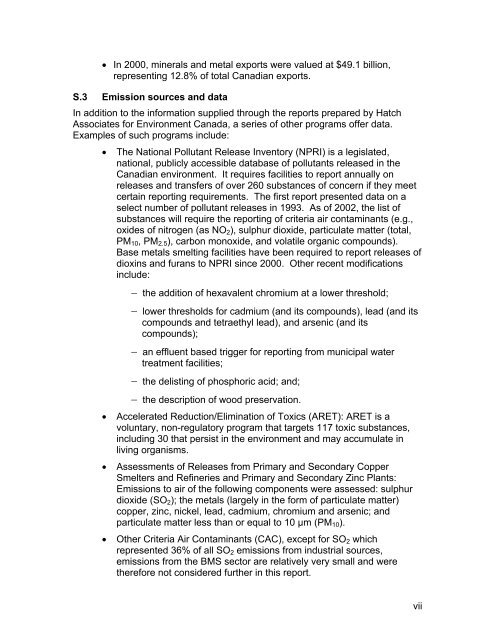(MERAF) for the Base Metals Smelting Sector - CCME
(MERAF) for the Base Metals Smelting Sector - CCME
(MERAF) for the Base Metals Smelting Sector - CCME
You also want an ePaper? Increase the reach of your titles
YUMPU automatically turns print PDFs into web optimized ePapers that Google loves.
• In 2000, minerals and metal exports were valued at $49.1 billion,<br />
representing 12.8% of total Canadian exports.<br />
S.3 Emission sources and data<br />
In addition to <strong>the</strong> in<strong>for</strong>mation supplied through <strong>the</strong> reports prepared by Hatch<br />
Associates <strong>for</strong> Environment Canada, a series of o<strong>the</strong>r programs offer data.<br />
Examples of such programs include:<br />
• The National Pollutant Release Inventory (NPRI) is a legislated,<br />
national, publicly accessible database of pollutants released in <strong>the</strong><br />
Canadian environment. It requires facilities to report annually on<br />
releases and transfers of over 260 substances of concern if <strong>the</strong>y meet<br />
certain reporting requirements. The first report presented data on a<br />
select number of pollutant releases in 1993. As of 2002, <strong>the</strong> list of<br />
substances will require <strong>the</strong> reporting of criteria air contaminants (e.g.,<br />
oxides of nitrogen (as NO 2 ), sulphur dioxide, particulate matter (total,<br />
PM 10 , PM 2.5 ), carbon monoxide, and volatile organic compounds).<br />
<strong>Base</strong> metals smelting facilities have been required to report releases of<br />
dioxins and furans to NPRI since 2000. O<strong>the</strong>r recent modifications<br />
include:<br />
− <strong>the</strong> addition of hexavalent chromium at a lower threshold;<br />
− lower thresholds <strong>for</strong> cadmium (and its compounds), lead (and its<br />
compounds and tetraethyl lead), and arsenic (and its<br />
compounds);<br />
− an effluent based trigger <strong>for</strong> reporting from municipal water<br />
treatment facilities;<br />
− <strong>the</strong> delisting of phosphoric acid; and;<br />
− <strong>the</strong> description of wood preservation.<br />
• Accelerated Reduction/Elimination of Toxics (ARET): ARET is a<br />
voluntary, non-regulatory program that targets 117 toxic substances,<br />
including 30 that persist in <strong>the</strong> environment and may accumulate in<br />
living organisms.<br />
• Assessments of Releases from Primary and Secondary Copper<br />
Smelters and Refineries and Primary and Secondary Zinc Plants:<br />
Emissions to air of <strong>the</strong> following components were assessed: sulphur<br />
dioxide (SO 2 ); <strong>the</strong> metals (largely in <strong>the</strong> <strong>for</strong>m of particulate matter)<br />
copper, zinc, nickel, lead, cadmium, chromium and arsenic; and<br />
particulate matter less than or equal to 10 µm (PM 10 ).<br />
• O<strong>the</strong>r Criteria Air Contaminants (CAC), except <strong>for</strong> SO 2 which<br />
represented 36% of all SO 2 emissions from industrial sources,<br />
emissions from <strong>the</strong> BMS sector are relatively very small and were<br />
<strong>the</strong>re<strong>for</strong>e not considered fur<strong>the</strong>r in this report.<br />
vii
















